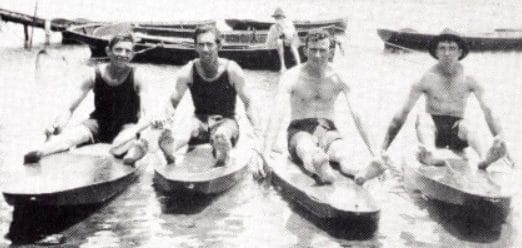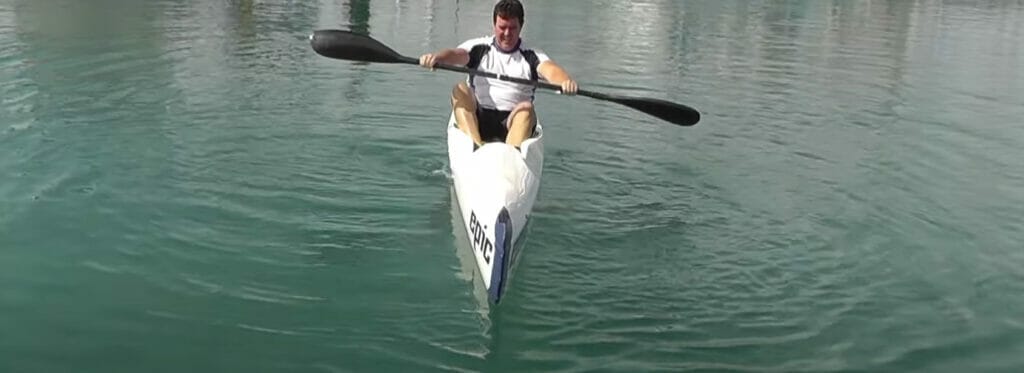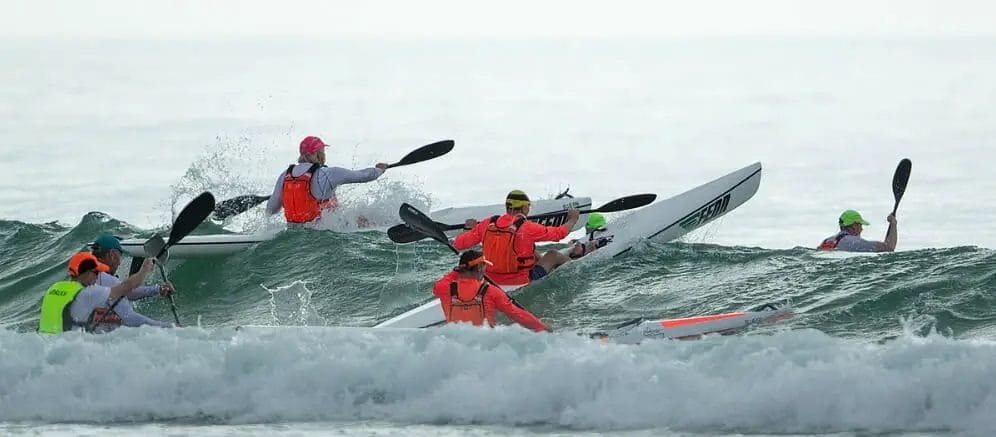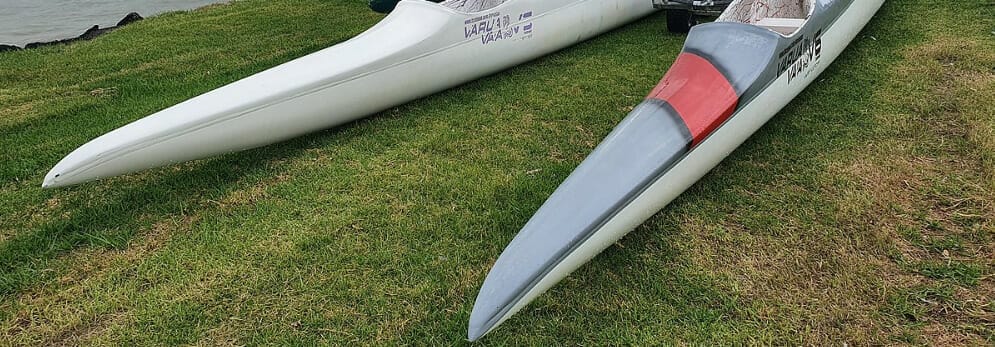Surfski Kayaking (Guide, Buying Tips, History)

Surfski kayaking is a dynamic and exciting water sport involving paddling on a long, narrow, lightweight kayak known as a surfski. Unlike traditional kayaks, surfskis are designed with an open cockpit and are typically used in open water conditions, such as oceans and large lakes.
Surfskis are built for speed and can handle waves and rough water with remarkable efficiency, thanks to their slim, torpedo-like shape.
The sport combines kayaking and surfing, with paddlers using a double-bladed paddle to propel themselves across the water surface, often riding on swells and waves, much like surfing. Surfski kayaking requires a blend of strength, balance, endurance, and technique, and it can be pursued recreationally and competitively.
Brief History of Surfski Kayaks

Surfski kayaking dates back to the early 20th century in Australia and South Africa. The sport’s origins are intertwined with surf lifesaving, a movement that began around the same period. Lifeguards sought a quick and effective way to reach swimmers in distress in the surf, leading to the development of the Surfski.
The initial Surfskis were rather primitive in design and crafted from wood. These long, narrow, lightweight vessels allowed lifeguards to cut through waves and reach victims swiftly. As they evolved, they were made even more streamlined and durable.
In the mid-20th century, the popularity of Surfski kayaking expanded beyond lifesaving clubs, and it began to emerge as a competitive sport in its own right. During this period, we witnessed a surge in Surfski races, especially in Australia and South Africa, where the water conditions were ideal for such activities.
The sport’s popularity in the latter part of the century was fueled by innovations in construction materials. Using fiberglass and, later, carbon fiber allowed for lighter, more durable, and faster Surfskis. This further boosted the appeal of Surfski racing and made it more accessible to the general public.
In recent years, Surfski kayaking has seen a global surge in popularity. Today, it is practiced and competed in various parts of the world, including North America, Europe, and Asia, in addition to its strongholds in Australia and South Africa.
Importance of Surfski Kayaking in Today’s Water Sports

SkiPaddling | Video
Surfski kayaking has carved a unique niche in water sports, known for its exhilarating blend of speed, agility, and open-water adventure. It holds immense significance in today’s water sports scene for several reasons:
- Promotion of Fitness and Health: Surfski kayaking is a full-body workout improving cardiovascular health, core strength, and overall body coordination. It’s an enjoyable way to stay fit, appealing to many who find gym workouts monotonous.
- Accessible Adventure Sport: Unlike other water sports, Surfski kayaking requires minimal equipment – a surfski and a paddle. It can be enjoyed in various water conditions, from calm lakes to challenging ocean swells, making it accessible to enthusiasts.
- Sustainable Recreation: Surfski kayaking is a non-motorized water sport, making it a sustainable and eco-friendly recreational activity that allows enthusiasts to enjoy nature without causing harm to aquatic ecosystems.
- Competitive Sport: Surfski kayaking has grown into an international competitive sport with events held globally, promoting camaraderie, sportsmanship, and cross-cultural exchanges.
- Lifesaving Roots: Its origins as a lifesaving tool highlight its practicality and usefulness beyond recreational and competitive spheres. Skills acquired in surfski kayaking can be valuable in emergencies in open water.
- Mental Wellness: Like other outdoor activities, surfski kayaking can significantly improve mental health. Combining physical exertion, connection with nature, and the thrill of riding the waves can provide stress relief and mental relaxation.
The Design and Construction of a Surfski Kayak
Surfski kayaks are carefully designed and constructed to provide speed, stability, and durability in various water conditions. Key factors influencing their design include the intended use, the user’s skill level, and the desired performance characteristics.
Materials Used

Surfski kayaks are generally made from composite materials, primarily fiberglass, carbon fiber, or a mix of both, known as Kevlar. The choice of material affects the weight, durability, and cost of the surfski.
- Fiberglass surfskis are heavier and more robust, making them a good choice for beginners due to their increased stability and lower cost.
- Carbon fiber surfskis, on the other hand, is lighter and more rigid, offering faster speed. More experienced paddlers and professionals usually prefer these, although they come at a higher cost.
- Kevlar surfskis blend the two, offering a good balance between weight, strength, and cost.
Design Elements and Why They Matter
Several design elements significantly impact a surfski’s performance:
- Length and Width: The dimensions of a surfski play a crucial role in its speed and stability. Longer and narrower surfskis are generally faster but require more skill to balance, while shorter and wider models offer more stability and maneuverability at the expense of speed.
- Hull Shape: The hull’s shape affects the surfski’s performance in different water conditions. A flat-bottomed hull provides stability in calm waters, while a V-shaped hull cuts through waves and choppy water more effectively.
- Cockpit Design: Unlike traditional kayaks, Surfskis features an open, self-draining cockpit. This design makes re-entry easier if the paddler falls out and allows water to drain quickly, a critical feature in rough seas.
- Rudder System: Most surfskis have an under-stern or over-stern rudder system controlled by foot pedals in the cockpit. This system helps the paddler steer and control the surfski, especially in windy conditions and strong currents.
Understanding the design and construction of surfski kayaks helps paddlers choose the right equipment for their needs and skills, enhancing their kayaking experience and performance.
Different Types of Surfski Kayaks and Their Specific Uses

Surfski kayaks have designs catering to different skill levels, water conditions, and user preferences. Here are some common types:
| Type of Surfski Kayak | Features |
|---|---|
| Beginner Surfskis | Wider and shorter for stability |
| Intermediate Surfskis | Longer and narrower for a balance of speed and stability |
| Racing/Advanced Surfskis | Longest and narrowest for high-performance and speed |
| Double Surfskis | Designed for two paddlers, great for tandem kayaking |
- Beginner Surfskis: These are typically wider and shorter to offer more stability, making them ideal for novices learning to balance and paddle. Their stability makes them less susceptible to capsizing in calm waters.
- Intermediate Surfskis: These are somewhat longer and narrower than beginner models, balancing stability and speed. They are suitable for paddlers who have mastered the basics and want to improve their skills.
- Racing or Advanced Surfskis: These are designed for speed and efficiency in open water conditions. They are usually the longest and narrowest surfskis, providing less initial stability but more speed. They’re meant for experienced paddlers and are commonly used in surfski competitions.
- Double Surfskis: These are designed for two paddlers, much like tandem kayaks. They’re great for couples, friends, or trainer-trainee pairs to enjoy surfskiing together.
Key Features That Distinguish Surfski Kayaks from Other Types of Kayaks

Surfski kayaks have several distinctive features that set them apart from other types of kayaks:
- Open Cockpit: Unlike traditional kayaks with enclosed cockpits, surfskis have an open, self-draining cockpit that makes re-entry easier if the paddler falls out.
- Length and Shape: Surfskis are generally longer and narrower than most other types of kayaks, aiding in speed and open-water performance.
- Hull Design: While the hull design can vary, surfskis usually have a semi-rounded or V-shaped hull that allows them to effectively cut through waves and choppy water.
- Rudder System: Most surfskis come equipped with an adjustable foot-operated rudder system for enhanced steering and control, a feature often absent in other types of kayaks.
- Lifeline and Handles: Most surfskis also have lifelines and handles for safety and convenience, making it easier for paddlers to re-mount their surfski after a capsize.
- Material: Surfskis are typically made from lightweight composite materials, such as carbon fiber or fiberglass, to enhance speed and durability. This contrasts with many other kayaks, often made from heavier plastic or polyethylene.
These unique features contribute to the surfski kayak’s reputation as a high-performance watercraft built for speed, wave riding, and open water conditions.
Learning to Ride a Surfski Kayak

SkiPaddling | Video
Surfski kayaking can seem intimidating initially due to its speed and open-water nature, but with the right training and practice, one can master this exciting sport.
Basic Skills Required for Surfski Kayaking
Before you hit the water, here are some fundamental skills to acquire:
- Balance: This is key in surfski kayaking as the vessels are narrow and require the ability to balance on moving water.
- Paddling Techniques: Learning the proper paddling stroke, including the forward stroke, reverse stroke, and sweep stroke, is critical for effective movement and control of the surfski.
- Body Conditioning: Surfski kayaking involves a full-body workout, so having a good fitness level can make learning easier.
- Swimming: As surfski kayaking often occurs in open waters, being a confident swimmer is essential for safety.
- Capsize Recovery: Also known as remounting, this skill allows you to get back onto your surfski if you fall off or capsize.
Detailed Steps to Learn Surfski Kayaking
Here’s a simple step-by-step guide to start learning surfski kayaking:
- Choose the Right Equipment: Start with a wider, more stable surfski as a beginner. You should also have a suitable paddle, personal flotation device (PFD), and other safety gear.
- Learn Basic Techniques: Understand the correct posture, paddle grip, and stroke techniques. You can learn these from online tutorials, books, or professional instructors.
- Practice on Flat Water: Begin your training on calm, flat water like a lake or a quiet bay. Practice basic paddling, steering with the rudder, and balancing the surfski.
- Learn to Remount: Practice falling off and remounting your surfski in safe, shallow water. This skill is vital for surfskiing in open waters.
- Gradually Progress to Open Water: Once comfortable with basic skills, you can start paddling under supervision in mild open water conditions.
- Join a Group or Club: Learning alongside other enthusiasts can provide guidance, motivation, and improve safety.
Safety Measures to Consider While Practicing
Safety is a critical aspect of surfski kayaking, and the following measures should be observed:
- Always Wear a PFD: A personal flotation device is mandatory for paddling safety.
- Use a Leash: Connect yourself to your surfski with a leash to prevent getting separated if you fall off.
- Monitor Weather and Water Conditions: Always check the weather forecast and understand the tide and current conditions before going out.
- Don’t Paddle Alone: As a beginner, ensure you have a buddy or a group, and inform someone on the land about your plans.
- Carry Communication Device: A waterproof communication device like a VHF radio or a cell phone in a waterproof case can be vital in case of an emergency.
Learning to ride a surfski kayak is a rewarding process that combines physical conditioning, technical skills, and an understanding of the marine environment. With practice and adherence to safety measures, you can enjoy this thrilling sport with confidence and skill.
How to Choose Your Surfski Kayak

Choosing a surfski kayak that suits your needs is essential for a successful and enjoyable kayaking experience.
Factors to Consider When Buying a Surfski Kayak
Several factors come into play when selecting the right surfski kayak:
Skill Level
Generally, wider and shorter surfskis are more stable and better suited to beginners, while narrower and longer surfskis are faster but require more balance and experience.
- Beginner: If you’re new to surfski kayaking, consider starting with a wider, more stable model that will allow you to learn the basics without worrying about tipping over.
- Intermediate: Once you’ve mastered basic skills, you may want to upgrade to a narrower and longer surfski that offers more speed and improved wave performance.
- Advanced: Experienced paddlers may opt for a high-performance surfski designed for speed and efficiency in various conditions. These models are typically longer, narrower, and less stable but offer superior performance for skilled paddlers.
Personal Preferences
- Water Conditions: The type of water you plan to paddle in should influence your decision. If you’ll mainly be on calm lakes or rivers, a stable, beginner-friendly surfski may suffice. A more performance-oriented model may be better if you plan to tackle ocean waves or windy conditions.
- Use: Consider whether you’ll use the surfski for casual paddling, fitness, or racing. Recreational paddlers might prefer comfort and stability, while racers prioritize speed and performance.
- Single or Double: Decide whether you want a single surfski or a double one. Double surfskis are great for couples, friends, or for coaching purposes.
Budget
Surfski kayaks can vary widely in price, from a few hundred to several thousand dollars, depending on the brand, model, materials used, and design.
- Consider Your Budget: While more expensive models often offer better performance, finding a surfski that fits your budget is important.
- New vs. Used: Used surfskis can be a good way to save money, especially when starting. Just make sure to inspect the surfski for any damage before buying.
The Process of Choosing and Buying the Right Paddle

Choosing the right paddle is just as important as selecting the surfski itself. Here are a few factors to consider:
- Length: Paddle length should be chosen based on your height and the width of your surfski. Taller paddlers and wider surfskis generally require longer paddles.
- Blade Size and Shape: Larger blades provide more power but require more effort, while smaller blades are easier to handle but provide less thrust. The shape of the blade can affect the paddle’s efficiency and the style of your stroke.
- Materials: Paddle materials affect the weight, performance, and price. Carbon fiber paddles are lightweight and efficient but tend to be more expensive. Fiberglass or plastic paddles are heavier and less efficient but more affordable.
- Adjustable vs. Fixed: Adjustable paddles allow you to change the length and blade angle, offering versatility. Fixed paddles are lighter and more direct in transferring power but must be sized correctly.
Remember, choosing your surfski and paddle is a personal decision based on your skill level, goals, preferences, and budget. It’s always a good idea to try before you buy, so consider renting different models or borrowing from friends or a club to see what you like best.
Top Brands and Models in the Market
The surfski market offers a variety of options, with several reputable brands producing high-quality kayaks for all levels of skill and experience. Here are some of the top brands and their notable models as of 2023:
| Brand | Notable Models |
|---|---|
| Epic Kayaks | V8 Pro, V10 Sport, V12 |
| Stellar Kayaks | S14S, SEI, SEL |
| Fenn Kayaks | Blue-Fin, Swordfish S, Elite S |
| Think Kayaks | Zen, Evo II, Uno Max |
| Nelo Kayaks | 520, 550, 560 |
- Epic Kayaks:
- Epic V8 Pro: A great beginner to intermediate surfski known for its stability and speed.
- Epic V10 Sport: An intermediate to an advanced model offering a great balance of speed, stability, and maneuverability.
- Epic V12: A high-performance model designed for advanced paddlers and racers.
- Stellar Kayaks:
- Stellar S14S: A stable and efficient surfski designed for beginners.
- Stellar SEI: An intermediate surfski offering an excellent blend of speed and stability.
- Stellar SEL: A high-performance surfski designed for speed and handling in various conditions.
- Fenn Kayaks:
- Fenn Blue-Fin: A beginner-friendly surfski offering excellent stability.
- Fenn Swordfish S: A popular intermediate model for its versatility in various conditions.
- Fenn Elite S: An advanced model with a narrower hull designed for speed and performance.
- Think Kayaks:
- Think Zen: An entry-level surfski designed for comfort, stability, and learning the basics.
- Think Evo II: An intermediate surfski that balances stability and speed well.
- Think Uno Max: A high-performance model for advanced paddlers, offering excellent speed and handling.
- Nelo Kayaks:
- Nelo 520: An accessible and stable surfski designed for beginners.
- Nelo 550: An intermediate to advanced surfski offering speed and maneuverability.
- Nelo 560: A racing surfski designed for top speed and performance.
These models offer many options for paddlers of all skill levels. As always, the best surfski depends on your needs, preferences, and budget. It’s always a good idea to test paddle a few different models before deciding.
The World of Competitive Surfski Kayaking

Surfski kayaking isn’t just a recreational sport but a highly competitive discipline with a rich history and a global following.
Introduction to Competitive Surfski Kayaking
Competitive surfski kayaking races can vary in distance, ranging from short sprints of a few kilometers to grueling marathon events covering dozens or even hundreds of kilometers.
These races occur in various conditions, from calm waters to challenging ocean swells and wind-driven waves.
Popular Surfski Kayaking Competitions Around the World
| Competition | Location | Distance |
|---|---|---|
| Molokai Challenge | Hawaii, USA | 53 km (32 miles) |
| Cape Point Challenge | South Africa | 50 km (31 miles) |
| The Doctor | Australia | 27 km (17 miles) |
| EuroChallenge | Spain | 20 km (12 miles) |
Several high-profile races have become mainstays on the international surfski calendar:
- Molokai Challenge (Hawaii, USA): Often considered the world championship of surfski kayaking, the Molokai Challenge is a 53 km (32 miles) crossing of the Kaiwi Channel between the Hawaiian islands of Molokai and Oahu.
- Cape Point Challenge (South Africa): This 50 km (31 miles) race around the Cape Peninsula is one of the world’s most iconic and challenging surfski events, often featuring challenging wind and wave conditions.
- The Doctor (Australia): Named after a famous wind that blows in Western Australia, The Doctor is a 27 km (17 miles) race from Rottnest Island to Sorrento Beach in Perth.
- EuroChallenge (Spain): This is one of Europe’s premier surfski events, featuring a 20 km (12 miles) downwind race along the Costa Blanca.
Profiles of Well-Known Surfski Kayakers
Several athletes have made a name for themselves in the world of competitive surfski kayaking:
- Oscar Chalupsky (South Africa): A 12-time winner of the Molokai Challenge, Oscar Chalupsky is considered a legend in the sport. His career spans several decades, and is known for his contributions to surfski design and coaching.
- Hank McGregor (South Africa): A multi-time world champion in both surfski and marathon kayak racing, McGregor is one of the most decorated athletes in paddle sports.
- Dawid Mocke (South Africa): A former world number one and founder of the Surfski School in Cape Town, Mocke is a successful competitor and a leading figure in promoting and teaching the sport.
- Teneale Hatton (New Zealand): A world champion in both surfski and sprint kayak racing, Hatton is one of the leading female athletes in the sport.
Competitive surfski kayaking is a thrilling spectacle that combines athleticism, technical skill, and a deep understanding of the ocean environment. Whether you’re an aspiring competitor or a casual observer, there’s no denying the excitement and drama of a surfski race.
References
- Surfski.info – An extensive online resource for surfski paddlers, including gear reviews, training tips, and race news.
- Paddle World Magazine – A global publication covering all aspects of paddle sports, including surfski.
- Websites of surfski manufacturers such as Epic Kayaks, Stellar Kayaks, Fenn Kayaks, Think Kayaks, and Nelo Kayaks.
